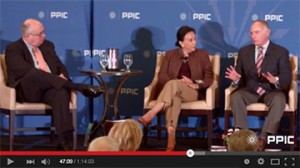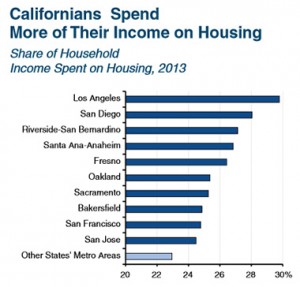Part III in a series from the PPIC, California—State of Change conference

Housing costs are one barrier to matching people with jobs, California Chamber of Commerce President and CEO Allan Zaremberg commented during the recent Public Policy Institute of California (PPIC) conference, California—State of Change.
On a separate question, Zaremberg noted that the diversity which is one of the strengths of the California economy also means there is no one “fix” that solves everyone’s economic problems.
Former state Senator Joe Simitian, now a member of the Santa Clara County Board of Supervisors, and Antonia Hernández of the California Community Foundation joined Zaremberg in a panel discussion on economic shifts, moderated by San Francisco Chronicle editorial page editor John Diaz.
Following is a third question posed to Zaremberg by Diaz. Check back at a later date for more questions and answers from this robust panel discussion.
Part I – Is the California Dream Back?
Part II – Is Higher Education Calibrated to Meet Workforce Needs?
Part III – Economic Shifts: Housing Costs and the Three ‘T’s’
Part IV – Is California Unfriendly to Business?
Diaz: Where does housing factor in the CalChamber’s thinking about the future for the California economy? Is it a hindrance? It certainly is in the Bay Area.
Zaremberg: You know, we come back to ‘what is the role of government’ in some of these and we clearly know, education, Joe [Simitian] mentioned transportation, it clearly is a role of government and I think housing is clearly a role of government and we used to have redevelopment zones that created funds that produced affordable housing and we need to find a way to go back and create a fund that does that.

By way of anecdote, a few years ago I asked one of the defense firms, ‘Where do you get your engineers everywhere?’ And he said, well, you know we might get one from Cal Tech and one from MIT, but the rest we get from San Jose State because they don’t have to move and the rest of the people in the country can’t afford to come here. Well I think, coming back to more than one California… the people from the Inland Empire and Fresno—they can’t afford to move to Joe’s district either. They can’t afford to be an engineer there and move there… Antonia talked a little about community colleges too. Most people go to school and live where they grew up in California and it’s even more restrictive because you can’t afford to move to where some of these jobs are…there are jobs available in San Francisco, in the Bay Area that they can’t fulfill…There was a budget crisis; we did away with redevelopment. There were abuses with redevelopment, but… we have to find a way to go back and say, when you create additional taxable property, because you’ve improved the property, can you take some of that increment and put it into some necessary programs—might be infrastructure, and it certainly should be affordable housing. I think that was one of the proven ways that when you did have redevelopment, it worked there…It is a role of government I think more so today than it has because it is a barrier… And it all comes back to, you talked about it, matching the job, the best job you can have in the state with the people who can do that job and one of the barriers is housing.
Diaz: Economists often talk about the three “T’s” in the California economy—tech, trade and tourism—and obviously all three are doing quite well right now, but given that we do have these gaps in the state, do we need to diversify the state economy and where do you see potential areas of opportunity?
Zaremberg: Well you know, that is what California has that most other states don’t have…diversity of jobs. When people complain about—Antonia [Hernández] mentioned regulations, and some people complain about taxes, some people talk about environmental regulations—it all depends on what business you’re in. There is no one fix for everybody in California, there is no one fix for every business owner or for every company. If you’re an energy-intensive industry, you care about energy prices. If you’re a labor-intensive industry—you mentioned tourism—you care about litigation and employment law and minimum wage and all those labor pressures… If you’re a high tech industry, you care about a qualified workforce…so… there is no one fix for everybody. Don’t ever look for… one arrow in your quiver that you can shoot that’s going to solve the economic problems in California. The beauty of that is we are a diverse economy, from agriculture to tourism to trade to technology to all these things, and that’s good. Doesn’t mean everybody doesn’t have issues, doesn’t have problems; taxes may be an issue for certain industries, but there isn’t one fix for everybody and you have to look at everything based on what their cost structure is because that’s what keeps them in California.


